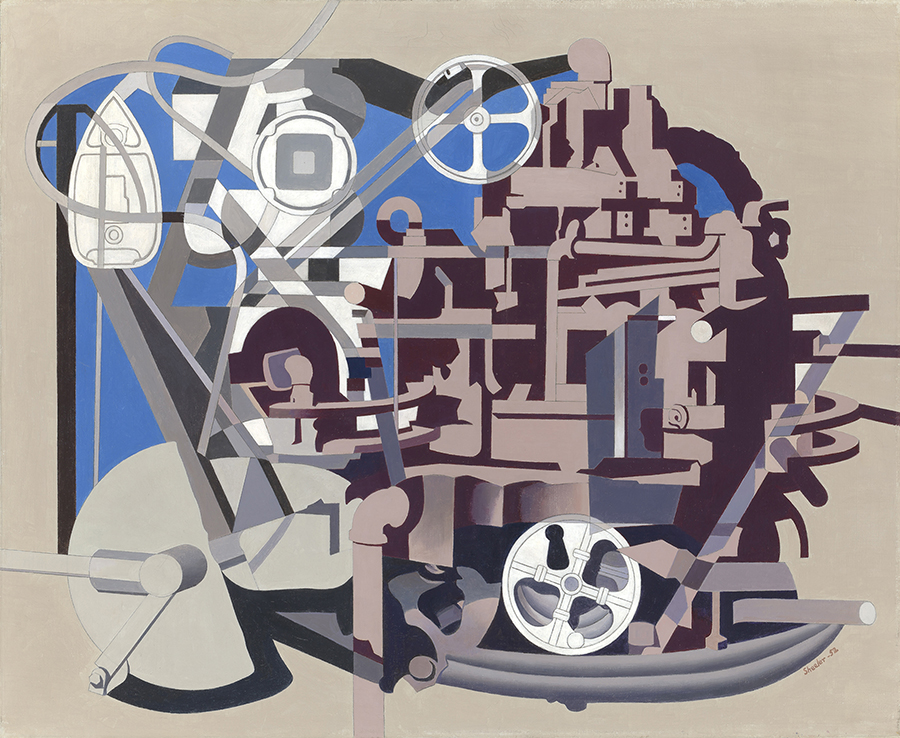Charles Sheeler
In the early 1950s, Sheeler received several important industrial commissions, the majority of which were arranged bythe Downtown Gallery in New York. These included commissions to visit Meta-Mold Aluminum (now AmcastIndustrial) Corporation in Cedarburg, Wisconsin, U.S. Steel in Pittsburgh, Pennsylvania, Inland Steel, near Chicago, Illinois, and the General Motors Laboratory in Warren, Michigan. He received the commission from Meta-Mold uponthe suggestion of the company’s chairman of the board Otto Spaeth, who formed a major collection of modernist American art. Meta-Mold Aluminum Corporation was a subsidiary of Spaeth’s company, the Dayton Malleable Iron Company. It created a large variety of products, including castings and die cast parts made of aluminum and magnesium metals, which they produced for a variety of American firms.
In June 1951, Sheeler reportedly traveled to Wisconsin to make preliminary sketches for the painting (“Two Wisconsin Charles Sheeler Works Finished,” The Milwaukee Journal, December 28, 1952, p. vii). He is known to have created at least one study in tempera, which he titled Meta-Mold, No. 2 [location unknown]. During this trip he also created his well-known photograph Tanks at Cedarburg. The May 18, 1953 issue of Life Magazine featured a photograph of Sheeler kneeling down to examine several of the parts that inspired his canvas [“The Creative Middle West Arts By and For The People Enliven and Enrich The Land,” Life Magazine [May 18, 1953]: 154). The painting itself is seen leaning against a nearby wall (Figure 1). The artist considered the new aluminum castings that he used as models to be “small jewels” (“Painter Sheeler Declares That Artist Should Quarrel,” The Milwaukee Journal, May 15, 1952).
Sheeler later discussed his relationship with Otto Spaeth and the circumstance of his visit to Cedarburg: “Otto was very beloved to me…and my relation [with him], which happened to have been for a short time, [was] quite close. He [would come] into the Downtown Gallery, and occasionally I met him down there…He had an idea [for me to go to a plant he owned twenty miles from Milwaukee]. And he said, ‘Would you be interested,’ and I said yes. He hadn’tsucceeded in selling the idea to the Corporation, but with the agreement that I would be interested, certainly in having alook, for that possibility. I think it took him four or five years, but he hung on to that, and he said, ‘Be on such and such atrain, the 20th Century, of such a day, and so forth, and I will see you out there.’…I was put up at Cedarburg, he had a casting plant there for a while…aluminum magnesium castings, small castings for those things, I mean, might become little parts for Chrysler, or whatever the end use of them would be.” (Interview with Charles Sheeler Conducted by Bartlett Cowdrey, At the Artist’s home, December 9, 1958, Archives of American Art).
Sheeler first turned to American industry as subject matter in the late 1920s, and returned to the theme regularly throughout his career. He came to greatly admire the functional and utilitarian beauty of industrial design. Sheeler’s flat planar treatment and severe reduction of forms, as well as his emphasis on geometry and pattern, developed out of his reinterest in Analytical Cubism in the early 1950s. Also apparent is his recent interest in overlapping transparent planes,which was influenced by his fascination with photographic multiple exposures. Frederick S. Wright remarked that in this painting and the related canvas Convolutions (1952, Private Collection), “We are somewhere between abstractionsand the renderings of a designer…it is as though he were…taking part in the first inception of the object” (“Charles Sheeler,” Art in America 42 (October 1954): 208). John I. H. Baur noted that in the early 1950s “Sheeler’s work became markedly more abstract. He began to apply visual tricks with substance and shadow, with observed reality and retinal after- images. The result was a series of pictures…which are extraordinarily rich and complex in their design. They…endow industrialism with an unlikely poetry” (“Introduction,” American Masters of the Twentieth Century [Oklahoma City, Oklahoma: Oklahoma Art Center, 1982], p. 12).
Charles Sheeler
Meta-Mold, 1952
Oil on canvas
25 1/4 x 31 inches
Signed and dated lower right
Provenance
The Downtown Gallery, New York
Meta-Mold Aluminum Company (now Amcast Industrial Corporation), Cedarburg, Wisconsin, 1952
Michael Altman Fine Art & Advisory Services, LLC, New York
Private Collection, Michigan, acquire from the above in 2009

